Activity
Children’s Activities Cambodia is not typically thought of as a top destination for children’s activities. Nevertheless, there are things to do that will amuse children and add to their cultural experience if you arrive here on a family holiday. There are ways for children to enjoy Angkor Wat with carefully planned itineraries and lots of cooling snacks, as well as a trip in a hot-air balloon. Alternatively, you can opt to take the little ones swimming, bowling or go-karting.
Angkor Wat in Miniature: Some kids might argue that this is better than the real thing and you can see it in a lot less time. Dy Preoung’s miniature Angkor Wat and surrounding temples made of sandstone and carvings are impressive no matter how old you are. The collection is located at his house and workshop to the north of Route 6, near the main river road in Siem Reap. There is a sign outside and most tuk-tuk drivers will be able to bring you here.
Hot-air balloon over Angkor Wat: An unforgettable experience awaits you over Angkor Wat with a 10-minute tethered balloon ride. Although short, it’s great for those who find small amounts of exhilaration to be enough. The cost is minimal and if you have a steady hand, you might get some great aerial photos.
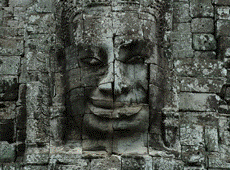 Kambol F1: Older kids and teenagers will enjoy a day away from the temples and on the track go-karting instead. Kambol is less than 10kms outside the capital in Kandal province and the track here is almost a kilometre long. The 200cc go-karts reach about 50kms per hour. Payment is expected in cash US dollars. Phone: +855 12 804 620.
Kambol F1: Older kids and teenagers will enjoy a day away from the temples and on the track go-karting instead. Kambol is less than 10kms outside the capital in Kandal province and the track here is almost a kilometre long. The 200cc go-karts reach about 50kms per hour. Payment is expected in cash US dollars. Phone: +855 12 804 620.
Phnom Tamao Zoo: This zoo is 40kms outside the capital and much more pleasant than you might expect, even enough so to be considered a good venue for a family day out. Most of the animals, including tigers, lions and elephants, have been rescued from maltreatment and their enclosures are large. The bears are especially fun to watch as they are playful in their compounds that are filled with tyre swings and other amusing devices. Be sure to book a vehicle for the day as the park is spread out and cannot be done on foot.
River tours: A relaxing way for the whole family to spend a few hours, boat rides on the Mekong and Tonlé Sap rivers can give great insight to the lives of those who live on and around the waters. The highlight is sightings of Cambodia's famous freshwater dolphins near Kratié.
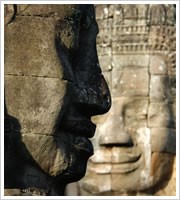 Silkworm Farm: Although it’s a bit out of Phnom Penh, the Silkworm Farm is worth the trip for small children to see. It’s interesting to see the little worms working and there’s even a chance to feed them. The silk produced by the worms is used to make colourful textiles onsite.
Silkworm Farm: Although it’s a bit out of Phnom Penh, the Silkworm Farm is worth the trip for small children to see. It’s interesting to see the little worms working and there’s even a chance to feed them. The silk produced by the worms is used to make colourful textiles onsite.
Souvanna Poum Theatre: Every youngster loves a good puppet theatre and this once dying art form is making a comeback since the end of Pol Pot’s reign. Souvanna Poum Theatre offers music, dance and traditional Khmer puppetry on Friday and Saturday evenings. Phone: +855 23 987 564.
Swimming: Kids will enjoy swimming at Sihanoukville or in one of many hotel swimming pools. Even if your hotel does not have a pool, there is probably one nearby that will allow entry for a small fee.
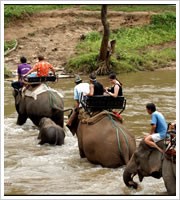 Ta Prohm and Beng Melea: Ta Prohm is still somewhat engulfed by jungle vines. It was originally built in 1186 as a monastery and unfortunately has been looted heavily in more recent times. Little ones will have fun exploring and pretending they are tomb raiders.
Ta Prohm and Beng Melea: Ta Prohm is still somewhat engulfed by jungle vines. It was originally built in 1186 as a monastery and unfortunately has been looted heavily in more recent times. Little ones will have fun exploring and pretending they are tomb raiders.
Cultural Activities Obviously the number one attraction in Cambodia is Angkor Wat in Siem Reap – and you’ll want to spend many days exploring the ruins here. The capital of Phnom Penh is also filledwith cultural sights leading back to the days of French occupation. Visiting a theatre is a great way to touch base with traditional Khmer music and dance. Viewing attractions that offer insight into the reign of the Khmer Rouge, although disheartening, are a must.
Angkor Wat: The temple complex is massive, covering just under 100sqkm and a minimum of 3 days should be spent here. The sunrises and sunsets are spectacular and you should ask your hotel or a guide about the best viewpoints. You can learn a lot about the temples, beyond just strolling about – and it’s advisable to hire a guide for a day or two, as they can explain the details of each structure. Tickets are sold for 1 day, 3 days or 1 week and should be paid in US dollars. Some of the outlying temples require an extra fee. The temples are open dawn to dusk. Angkor Wat itself was built in the 12th century and is an incredible example of Khmer architecture.
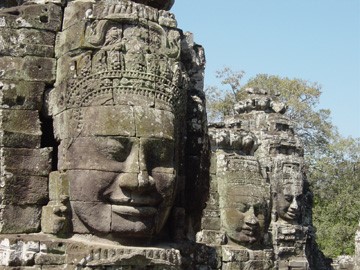 Angkor Thom: A must-see, Angkor Thom means ‘the great city’ in Khmer and covers an extensive area with highlights being Bayon and Baphuon. Bayon is the crowing glory of Angkor Thom and is especially adored for its carved faces. Built in 1190, this is a Buddhist temple built atop a previous Hindu site. It’s one of the best sites to visit along with a guide who can tell you some of stories of the temple.
Angkor Thom: A must-see, Angkor Thom means ‘the great city’ in Khmer and covers an extensive area with highlights being Bayon and Baphuon. Bayon is the crowing glory of Angkor Thom and is especially adored for its carved faces. Built in 1190, this is a Buddhist temple built atop a previous Hindu site. It’s one of the best sites to visit along with a guide who can tell you some of stories of the temple.
Artist Street: This popular strip in the capital that is actually named Street 178 is chock full of local artists with some great talent selling their wares. One of the highlights is Kravan House, offering stunning Cambodian silk products and other handmade items. Another great stop-off is Stef’s Happy Painting where the art is far from the typical gruesome reminders of the Khmer Rouge.
Aspara Theatre: Inside Angkor Village Resort, the Apsara Theatre offers dinner along with a show from 19:00 every evening. Be dazzled as the Aspara Ballet Troupe performs traditional Khmer theatre with a heavy emphasis on the life and times of past kings. A bright, colourful touristy event, this is a great way to experience a taste of genuine Khmer theatre. Phone: +855 63 963363.
Chatomuk Theatre: Another good place to experience traditional Khmer song and dance, Chatomuk is located at Sisowath Quay in the capital. Songs are performed in Khmer but even so, you will still enjoy the music and the bright costumes. Phone: +855 23 725 119.
Kampong Phluk: Well wroth the 2-hour drive outside of Siem Reap, this traditional floating village makes a fascinating trip with plenty of photo opportunities. See how the Khmer traditionally lived on Tonlé Sap lake. Any tour operator can arrange the trip for a reasonable price.
Killing Fields and Choeung Ek Memorial: Less than 20kms south of the capital, these grounds were once a Chinese cemetery. However, from 1975 to 1979, they were used by the Khmer Rouge under Pol Pot as execution grounds. There are mass graves, human skulls and more. It is a place everyone should see once in their lives.
Land Mine Museum: If you need a break from the temples, take a couple hours to visit the Land Mine Museum in Siem Reap. Not your typical museum, it nonetheless offers some handy information about land mines and is interesting.
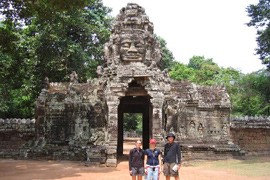 National Museum of Phnom Penh: If you’re going to visit a museum, then this is the one to see. It has been open since 1920 and houses artefacts from all regions of Cambodia. There are descriptions of items in English, but hiring a guide is recommended. Phone: +85523 211 753.
National Museum of Phnom Penh: If you’re going to visit a museum, then this is the one to see. It has been open since 1920 and houses artefacts from all regions of Cambodia. There are descriptions of items in English, but hiring a guide is recommended. Phone: +85523 211 753.
Royal Palace and Silver Pagoda: Located in Phnom Penh, the somewhat fancy Royal Palace was constructed in the 1860s and is well worth a look for its elaborate décor. Just south of it and included in the ticket to see the palace, the Silver Pagoda is a charming temple laced with 5,000 silver blocks and home to a Buddha constructed of Baccarat crystal as well as one made of gold and 10,000 diamonds.
Tuol Sleng S-1, Museum of Genocide: A former high school in Phnom Penh, this compound was converted into an infamous torture camp where many people came before being murdered in the Killing Fields. It’s estimated around 17,000 political prisoners were tortured and killed here or in the nearby Killing Fields between 1975 and 1979. Tuol Sleng (also called S-21) is one of the places where viewing with a guide is recommended, as many have personal experience with the prison. One wing of the building is devoted to the harrowing photos of prisoners, taken when they first arrived at the camp. Phone: +855 23 300698.
Wat Phnom Sampeou: Located some 15kms from Battambang, this is a 2002 reconstruction of a Buddhist temple that was originally built in 1964. The history of this temple as part of the Killing Fields is what makes it interesting though. People were slaughtered and thrown into the caves here. A visit takes you through the temple, caves and prison building.
Dining & Shopping Much like the cuisine of the surrounding countries, Khmer food contains fewer spices. There are also many restaurants in the larger cities serving Vietnamese and Chinese dishes. However, the local cuisine is the most interesting and well prepared. A typical meal contains soup and rice with fish. One must-try is the speciality of grilled freshwater fish that has been wrapped in lettuce or spinach, and served with a nutty fish-sauce dip. Another fish treat is amok, fish steamed in bamboo leaves with curry and coconut milk. Salads are spiced with lemongrass, mint and coriander.
There’s still plenty of French influence in the cuisine as well, with baguettes seen everywhere and a good smattering of French restaurants in the larger cities. Bread carts can be found along the city streets, especially in the capital, and contain sweet breads alongside baguettes. There are also some Vietnamese baguettes filled with pâté.
Your sweet tooth will definitely be satisfied with desserts of cakes and sweet breads, as well as unique treats made from rice and coconut milk. Perhaps the best dessert though is the many tropical fruits ranging from durian and jackfruit to mangosteen and rambutan.
If you can tear yourself away from the many activities on offer, the shopping is also worth a spot of time, if only for souvenirs at least. If you’re in the capital, you should take time out to see the Central Market, which has been in operation since 1937. As well as being a spectacular photo opportunity, the market offers a plethora of goods including jewellery, silk, souvenirs, handicrafts and more.
Although Cambodia’s silk weaving fell by the wayside for a time, it’s now coming back and you can find some really beautiful pieces. There’s also attractive hand-carved wood souvenirs and fine metalwork. Popular gifts to take home include silver, sarongs, hats, copies of ancient Khmer art and figurines.
The krama makes a great inexpensive gift. It is much like a scarf and they come in many colours – and are seen worn by both men and women all over the country. Clothing, décor and handbags made from natural fabrics are all great bargains. Silver shops are increasingly popular in Phnom Penh and village centres such as Tul Mau, 30kms to the north.
Baskets and other items woven out of bamboo are also light souvenirs that can be easily carried home. Many landmine victim rehabilitation programmes assist people with creating items for sale and this is a great way to purchase a souvenir and also do some good for others. Betel nut boxes make really cute souvenirs with their intricate designs or animal shapes made of silver. Rice paper prints – essentially charcoal rubbings of carvings from temples – are good mementos too.
It’s illegal to sell and export registered antiques. And although many artefacts have been stolen over the years and now reside in other countries, it’s doubtful you’re going to come across any. However, there are lots of fakes that can look nice in your home, as long as you know you’re paying for a reproduction.
Outdoor Activities Tourism is just taking off in Cambodia and your main activities are likely to be sightseeing, eating and shopping. However, tourist-oriented areas such as those of the bigger cities are now offering some leisure activities ranging from jet-skiing to elephant trekking.
Dirt-biking: Quite a popular activity, dirt-biking is done along many off-road trails in the region that are reputably the best in the world. There is also a motocross track in Phnom Penh with races every month.Visit this website for further information about Dirt-Biking in Cambodia.Elephant trekking.
Elephant trekking can be done in Ratanakiri and Mondulkiri, and is a fantastic experience and a great way to see the jungles of Cambodia. However, you should be sure to take a guide, as setting out on your own can be dangerous. Obviously you will have a mahout with you, but a certified guide will be able explain the lay of the land to you and provide a good itinerary, allowing you to make the most of your experience.
Visit this website for further information about trekking around Ratanakiri in Cambodia.Golf. There are three golf courses in Cambodia: Cambodia Golf & Country Club is an hour’s drive south of the capital; Royal Phnom Penh Golf Course is just half an hour out of the city; and Siem Reap’s Phookethra Country Club is the city’s first and is managed by the Sofitel Resort.
Horseback riding: Happy Ranch International is an international stable with foreign instructors offering lessons. Rides are possible within in the compound and on nearby trails, and all equipment is included in the price of your ride. It’s a little bit out of the city on the road from Sivitha so make sure to check with a taxi driver that he knows where to go.
Scuba diving: Thus far, the only place to see what lurks below the waves is Sihanoukville. The diving is still pristine here with lots of marine life including giant clams. There are more than 20 islands in the area as well as coral reefs, all within a day’s reach by boat. You’ll find three groups of islands: Som, Ream and Royal. Reputed as the best diving areas are the waters off the islands Tang, Prins and Poulo Wai which have visibility up-to 40 metres. The waters off Prins Island contain some shipwrecks and a downed US helicopter at 35 metres. Visit this website for further information about diving in Sihanoukville.Shooting ranges.
Just outside Siem Reap near Banteay Srei, there is a semi-legal shooting range that is popular among those who want the chance to fire something they wouldn’t be able to anywhere else. Try the likes of an M-16 or even a rocket launcher, but don’t expect it to be cheap. Thunder Ranch is another similar venue outside the capital, near Cheoung Ek.
Tonlé Sap Lake and Exhibition: Just a tiny way out of Siem Reap, this is the largest body of water in Southeast Asia and is a vibrant ecosystem supporting many species of birds and other wildlife along with the local human population, some of which live in attractive houses on stilts out on the water at the village of Chong Kneas. Before you go to the actual lake, stop at the lake’s exhibition inside the city to examine artefacts and explanations of the Tonlé Sap eco-system. Especially interesting is the working model explaining the complex water system that connects the lake to the Tonlé Sap and Mekong rivers.
Trekking: While a popular activity, trekking in Cambodia is still limited due to the many thousands of unexploded land mines in the more remote areas. However, there are still plenty of cleared and marked routes around Ratanakiri that are frequented by visitors. You should never stray from main paths, and it’s always advisable to take a local guide